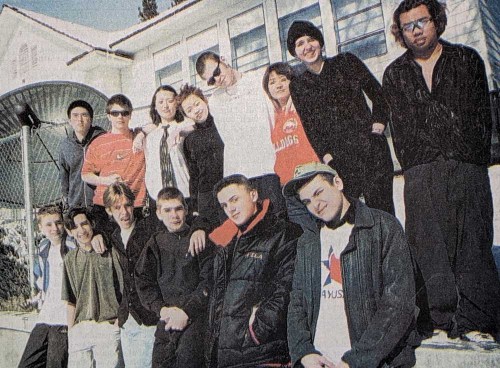East Oregonian Days Gone By for the week of Feb. 11, 2024
Published 5:00 am Tuesday, February 13, 2024

- 1999 — Ukiah is home to 14 exchange students from 11 countries during the school year. They include front row from left, Henrik Imhof of Germany, Daniel Mendonca of Brazil, Mario Paladini of Argentina, Alban Janku of Albania, Ridvan Akui of Yugoslavia and Sergei Etdyaev of Russia; and back from left, Takehiko Okabe of Japan, Emil Gahlin of Sweden, Saki Ochi of Japan, Ryoko Shimizu of Japan, Graham Hunter of Scotland, Reiko Nakachi of Japan, Anka Hrynniak of Poland and Jarkchai Chungsap of Thailand.
25 years ago this week — 1999
Barbara Streisand, Frank Sinatra, Miles Davis, even Chaka Khan have recorded “My Funny Valentine” — Sweet comic Valentine. You make me smile with my heart. Your looks are laughable, unphotographable, Yet, you’re my favorite work of art.
But perhaps, no one has ever rendered a more sensuous version of the 1937 Hart and Rodgers classic than the ethereal jazz vocalist Sarah Vaughn. The memory of hearing Vaughn sing the quintessential Valentine Day song still delights the heart of Bard J. Bertels.
Bertels, who now is a retail clerk at Birch Creek Creations was an United States Airlines flight attendant based out of JFK airport in New York City during the early 1960s. One of her favorite hangouts was New York’s Cafe Metropole, where she enjoyed listening to jazz.
“Many of us United flight attendants would go in after our flights.”
At the Metropole, guests were always sure to find Dixieland jazz in the heart of New York City. One of the club’s regular entertainers included The Cozy Cole Combo.
———
The Ukiah School District’s service area stretches a little farther than most, thanks to a successful student exchange program that brings the world to its doorstep.
This culture swap boosts everything from academics and sports to the spirits of the community.
Fourteen students from 11 countries — Albania, Germany, Argentina, Poland, Scotland, Japan, Brazil, Russia, Yugoslavia, Thailand and Sweden — are the latest wave of international ambassadors connecting this tiny town nestled in the Blue Mountains 51 miles south of Pendleton to other parts of the planet. Consider the exchange program an umbilical cord that nourished both students and their hosts.
“This is one way to offer classes in response to the school reform movement of the 21st century,” said Dan Korber, principal of both Ukiah elementary and high school. “It keeps our numbers up, allowing us to offer classes to the local kids. If we didn’t have the exchange students we’d have to cut programs and possibly not have a school.
After facing declining enrollment in the early 1990s, the district initially augmented its numbers by opening a boarding school for at-risk students from around the state in 1993. In 1996, the school and community opened the door to the rest of the world by hosting foreign exchange students.
———
The sound of pounding rocks filled Crow’s Shadow Institute earlier this week as Otomi artisans brought a little bit of Puebla, Mexico, to northeast Oregon.
The artists from the Mbith Nanhu Cultural Center traveled to Umatilla Indian Reservation on Monday to meet with native – and not so native – artists.
“These guys are pretty much the last guys who make it,” explained the artists’ translator, Kerin Gould of Davis, Calif. Gould, who lived in the village for several years, is traveling wit the group to California and Oregon.
In Mission, the artists guided a group of about 20 through the steps of making amate paper, an ancient process that dates back to “long before the Spanish came,” Gould said.
The traditional art form was kept alive over centuries because of its pivotal role in Otomi religious ceremonies.
“In the past and still today, they use the paper for curing,” Gould said.
The San Pablito a community in Mexico, home of the three artisans, is now a cooperative that depends on the amate paper art as a means of economic survival.
50 years ago this week — 1974
Oregon’s fertilizer shortage will get worse before it gets better, witnesses at a legislative subcommittee hearing agreed Tuesday.
“We’re looking at a tight fertilizer market for at least three years,” said H. J. Ostlind, Portland, Northwest district manager for Ortho fertilizers.
“The shortage is going to get more acute as long as demand continues to grow, as we expect it to, on a worldwide basis,” he said.
The hearing was the first of two scheduled by the industrial agricultural development subcommittee of the Committee of Trade and Economic Development. The subcommittee is searching for legislative solutions to a fertilizer shortage that threatens Oregon agriculture in the coming crop season.
Larry Blue, manager of the agricultural supply department of Van Waters and Rogers, a fertilizer blending firm, estimates the shortage in Oregon at 35 to 40 percent. His firm’s supplies of urea and ammonium sulfate, two important fertilizer components, have been cut 10 to 25 per cent, Blue said.
The production of anhydrous ammonia, another major fertilizer produced from natural gas, has fallen back because of the natural gas shortage.
———
The Old Oregon Trail left a deeper impression on the Oregon country than two-foot ruts winding down the Blue Mountains, 50 people were told Thursday night
The group gathered in the Blue Mountain Community College theater in Pendleton to hear Howard Chadwick, Seattle, of the Bureau of Outdoor Recreation, explain a federal plan to save what is left of the historic route that brought civilization to the American West.
“Many places aren’t scenic,” Chadwick said, “But the emigrants weren;t out to see the pretty country. They were trying to get from point A to point B. “
On the way to point B, which was usually the Willamette Valley, emigrants cut a precarious path through Northeastern Oregon. Evidence of the route is visible throughout the region, but annually portions of the rutted trail succumb to plow and pavement.
Chadwick and BOR want to protect the trail. The 50 gathered in the BMCC theater agreed.
Harold Dobyns, Pendleton, a trapper in the Oregon country for many years, told of the slow destruction of the winding path.
“There used to be markers of wood,” he recalled, “but that was 68 years ago and most are lost now.”
Dobyn’s mother had a birthday on the old trail.
———
A recent survey by The Associated Press of 10 Oregon cities showed Pendleton has the highest overall gasoline prices. Nothing New.
Residents of this area have known for years that Pendleton gas prices were among the highest, if not the highest, in Oregon. But why?
On the surface, one might think transportation costs would be the reason. Gasoline enters Oregon on the west side of the Cascades, and Pendleton is a fur piece from Portland. But under that theory, gas would be higher in La Grande, Baker and Ontario, which are farther from Western Oregon than Pendleton.
Looking at gasoline prices around Oregon for a few years blows the theory that gasoline prices are determined by the distance of the community from the main supply point. In fact, such distances seem to have nothing to do with the prices at the retail pump.
Inquiries by the East Oregonian in past years have failed to come up with an answer.
Whatever the answer, it’s a substantial one. Even with the critical shortages of gasoline and greater demand in the Willamette Valley, the highest prices in the state remain in Pendleton.
100 years ago this week — 1924
That there is need of a strong, continued letter writing campaign by local business houses in support of the McNary-Haugen bill is shown by responses being received from Portland wholesalers to whom merchants have written.
H. W. Collins is in receipt of answers by wire and letter from various concerns with which Alexander’s store has dealings. An extended letter from Nathan Strauss of Fleischner, Mayer Co. promises support for the measure and indicates an intelligent grasp of the plan on the part of Mr. Strauss. He says that sentiment in Portland is by no means unanimous and that many people there feel as he does.
On the other hand some of the replies indicate gross ignorance of the subject or indifference. One reply takes the position that the measure covers a subject not of direct interest to the wholesaler. A caustic answer was sent to that firm by Mr. Collins.
From Seattle wholesalers a broader attitude is shown and they refer to the fact that the Seattle chamber is now giving consideration to the measure.
———
Portland is seriously considering the idea of having a big pageant in connection with their annual rose festival and if the plan is taken up J. R. Raley of Pendleton may be director of the affair. Mr. Raley returned from Portland this morning after conferring with committees there yesterday and on Wednesday. He went down in answer to a wire requesting his attendance and has been before the Portland committee once before on the same mission.
Observing that the Round-Up succeeds financially as well as an entertainment various Portlanders has been inquiring the reason why and some time ago Mr. Raley was called into counsel. He advised the Portlanders they needed an inclosed show where an admission could be charged. He outlined the idea of a great pageant during the rose festival and the committees seemed enthused over the matter. Thus far no definite action has been taken however, Under Mr. Raley’s estimate the sum of $150,000 would be needed to finance the plans he has in mind. The enthusiasts in Portland say double that sum will be raised if the move is undertaken.
———
There’s hardly a time in the year when farmers are not interested in weather conditions, but right at present they are almost as anxious as they are when awaiting the June rain that gives the wheat its final drink before harvest time. The cause of anxiety now is the heavy damage that might accure to the crop by reason of a sudden cold wave.
Wheat has been growing nearly all winter, farmers declare, and as a result several of the spring wheat varieties such an Jenkins, Federation and Red Chaff have almost arrived at the jointing stage. Many plants of these three varieties are from six to 10 inches high from the ground to the tip of the plant, and zero weather without a covering of snow might easily kill one-third of the acreage, according to Fred Bennion.





